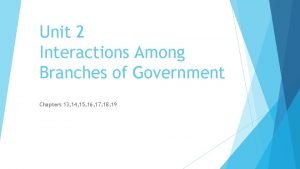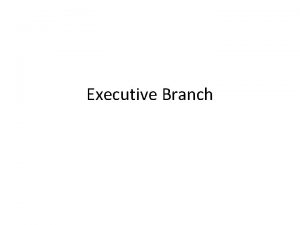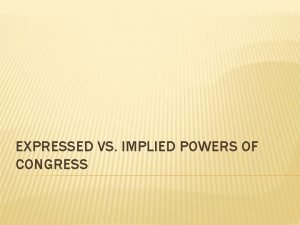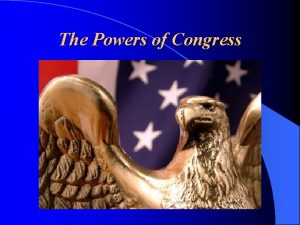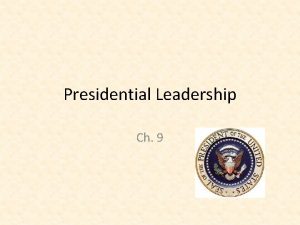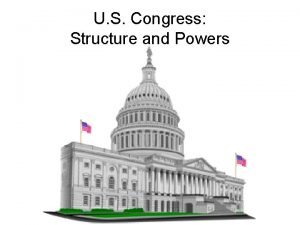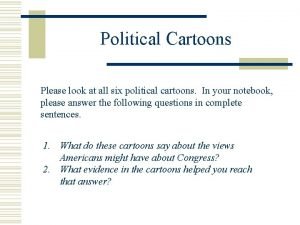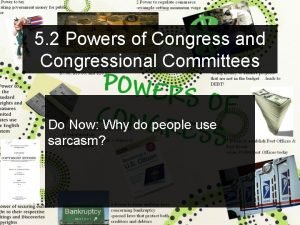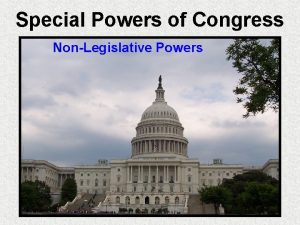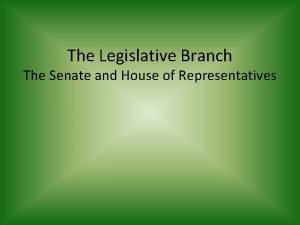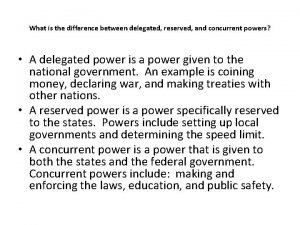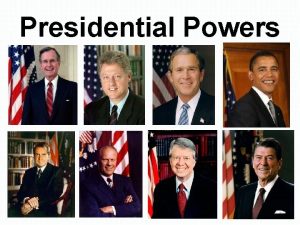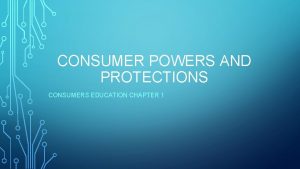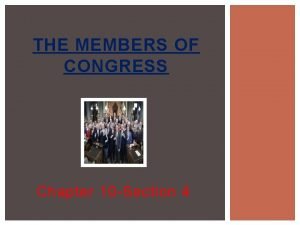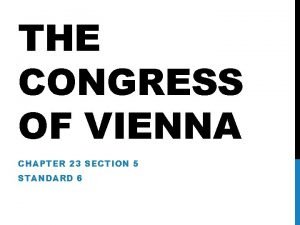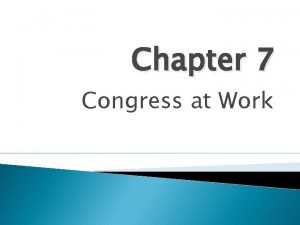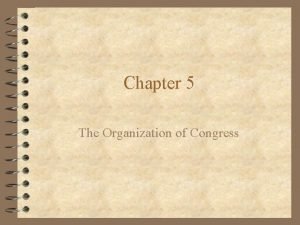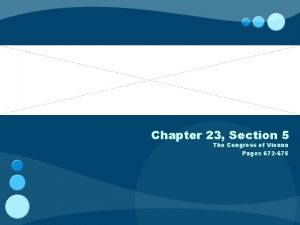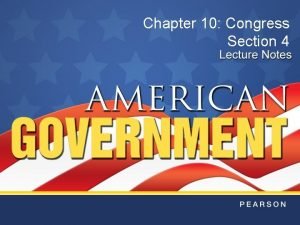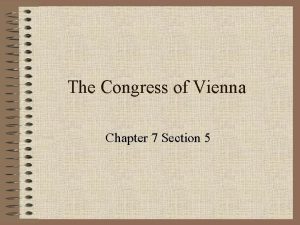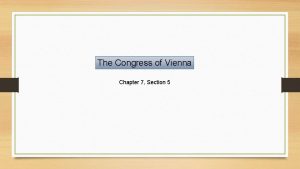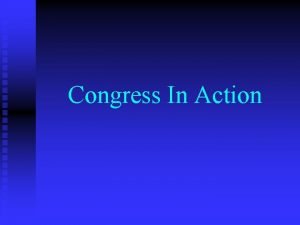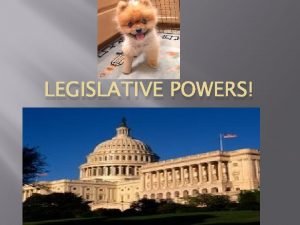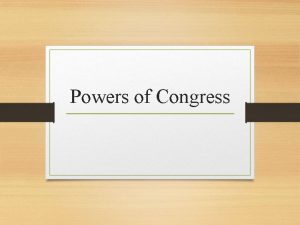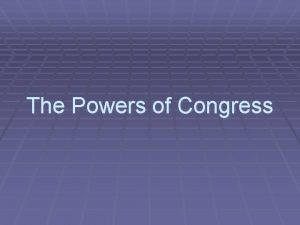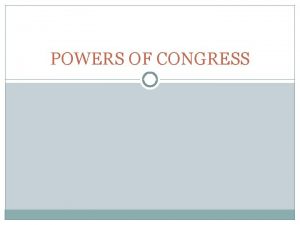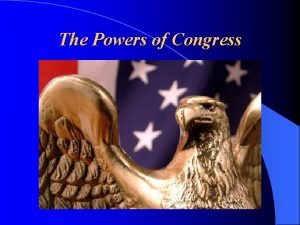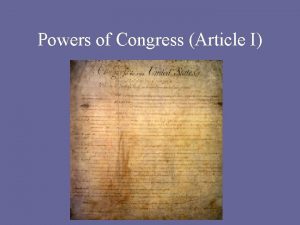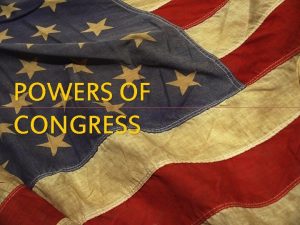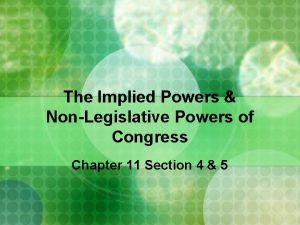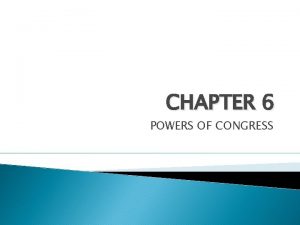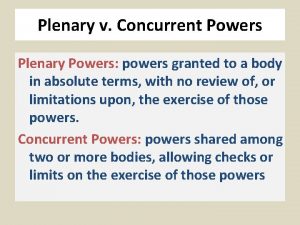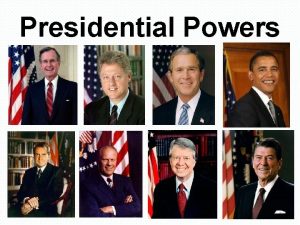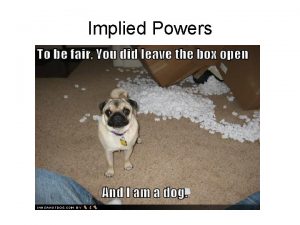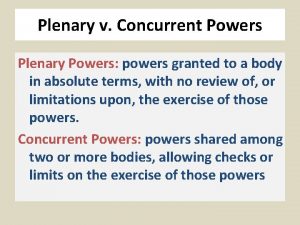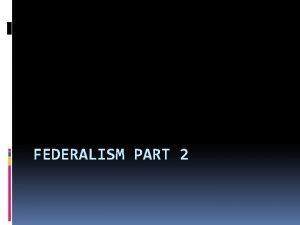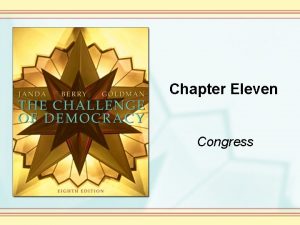Chapter 11 Congress The Origin and Powers of



































- Slides: 35

Chapter 11: Congress

The Origin and Powers of Congress • The Great Compromise – Representation in the House is based on population – Each state has two senators (equal representation for small states) Copyright © Houghton Mifflin Company. All rights reserved. 11 | 2

The Origin and Powers of Congress • Duties of the House and Senate – The House of Representatives • Initiates impeachment proceedings against a President or other government official • Originates revenue bills – The Senate • Votes to convict impeached President or other officials • Must approve major presidential appointments • Sole power to affirm treaties Copyright © Houghton Mifflin Company. All rights reserved. 11 | 3

Electing Congress • The Incumbency Effect – Incumbent: a current officeholder – Incumbents have a very high reelection rate – Yet the public does not hold Congress in very high esteem – Voters seem only to be satisfied with their own representatives Copyright © Houghton Mifflin Company. All rights reserved. 11 | 4

Electing Congress • The Incumbency Effect – Redistricting • Gerrymandering: redrawing a congressional district to intentionally benefit one party • May be done to benefit incumbents Copyright © Houghton Mifflin Company. All rights reserved. 11 | 5

Electing Congress • The Incumbency Effect – Name Recognition • Recognition increased by being member of Congress • Franking privilege: the right to send mail free of charge Copyright © Houghton Mifflin Company. All rights reserved. 11 | 6

Electing Congress • The Incumbency Effect – Casework • Casework: solving problems for constituents, especially problems involving government agencies • Structure of congressional offices is built around casework Copyright © Houghton Mifflin Company. All rights reserved. 11 | 7

Electing Congress • The Incumbency Effect – Campaign Financing • Incumbents have significant advantage in fundraising • PACs have strong preference for incumbents Copyright © Houghton Mifflin Company. All rights reserved. 11 | 8

Electing Congress • The Incumbency Effect – Successful Challengers • The opposing party and sympathetic PACs may target vulnerable incumbents, thus giving a challenger a better chance to succeed • Vulnerable incumbents bring out higher quality challengers Copyright © Houghton Mifflin Company. All rights reserved. 11 | 9

Electing Congress • The Incumbency Effect – 2002 and 2006 Elections • Off-year election: the congressional election between presidential elections • Traditionally not good for party holding the White House • 2002: only 3 rd time since the Civil War the President’s party has gained House seats at midterm Copyright © Houghton Mifflin Company. All rights reserved. 11 | 10

Electing Congress • Whom Do We Elect? – Most members of Congress are professionals – Women and minorities have long been underrepresented, but numbers are increasing • Descriptive representation: a belief that constituents are most effectively represented by legislators who are similar to them in such key demographic characteristics as race, ethnicity, religion or gender • Voting Rights Act of 1982 provided support for descriptive representation Copyright © Houghton Mifflin Company. All rights reserved. 11 | 11

Electing Congress • Whom Do We Elect? – Racial gerrymandering: the drawing of legislative districts to maximize the chance that a minority candidate will win election • Shaw v. Reno (1993) deemed racial gerrymandering unconstitutional • Supreme Court modified this position in 2001, saying race could be a consideration in drawing congressional districts Copyright © Houghton Mifflin Company. All rights reserved. 11 | 12

Not Exactly a Vote of Confidence Copyright © Houghton Mifflin Company. All rights reserved. 11 | 13

How Issues Get on the Congressional Agenda • Agenda: the broad, imprecise, and unwritten agenda comprising all the issues an institution is considering • Many issues have been on the agenda a long time • Other issues emerge suddenly, often due to technological change Copyright © Houghton Mifflin Company. All rights reserved. 11 | 14

How Issues Get on the Congressional Agenda • Issues may reach the agenda in many ways – A highly visible event (like Sept. 11 th) draws our attention to a problem – Presidential support – Congressional party leaders and committee chairs – Interest group efforts Copyright © Houghton Mifflin Company. All rights reserved. 11 | 15

The Dance of Legislation: An Overview • Series of specific steps, but legislation can be treated differently at each step • Introduction Assigned to committee Assigned to subcommittee – Subcommittee may hold hearings; bill is modified or revised; if passed is sent to full committee – Bill approved by full committee is reported to the entire chamber – Chamber may debate, amend, and pass or defeat Copyright © Houghton Mifflin Company. All rights reserved. 11 | 16

The Dance of Legislation: An Overview • Bills coming out of House committees go to Rules committee – Rules committee attaches rule to the bill that governs floor debate – On major legislation, rules can be complex • Senate does not have comparable committee Copyright © Houghton Mifflin Company. All rights reserved. 11 | 17

The Dance of Legislation: An Overview • Senate and House versions have to be reconciled by conference committee – Compromise version has to go to both houses for a vote – If both chambers approve, bill goes to president Copyright © Houghton Mifflin Company. All rights reserved. 11 | 18

The Dance of Legislation: An Overview • President’s action – Sign – Veto – Neither sign nor veto within 10 days bill becomes law – Neither sign nor veto within 10 days but Congress adjourns pocket veto • Content of bill can be changed at any time in legislative process Copyright © Houghton Mifflin Company. All rights reserved. 11 | 19

The Legislative Process Copyright © Houghton Mifflin Company. All rights reserved. 11 | 20

Committees: The Workhorses of Congress • Committees develop and use expertise in specific areas • Committee types – Standing – Joint – Select – Conference Copyright © Houghton Mifflin Company. All rights reserved. 11 | 21

Committees: The Workhorses of Congress • Congressional Expertise and Seniority – Influence on committees grows formally with seniority – Influence on committees grows informally with increased expertise – Senior member of the majority party usually becomes the committee chair Copyright © Houghton Mifflin Company. All rights reserved. 11 | 22

Committees: The Workhorses of Congress • Public policy decision-making takes place in committees – Committees hold hearings – Markup sessions: the meetings at which committees debate and amend legislation Copyright © Houghton Mifflin Company. All rights reserved. 11 | 23

Committees: The Workhorses of Congress • Oversight: the process of reviewing the operations of an agency to determine whether it is carrying out policies as Congress intended – Oversight has become more difficult – Congress has added resources to perform the oversight function • Majoritarian and Pluralist Views of Committees Copyright © Houghton Mifflin Company. All rights reserved. 11 | 24

Leaders and Followers in Congress • The parties’ leadership hierarchy • Rules of Procedure – Amendments • House: amendments must be germane • Senate: non-germane amendments are generally accepted – Floor debate • House: Rules Committee governs floor debate • Senate: Debate governed by unanimous consent agreement Copyright © Houghton Mifflin Company. All rights reserved. 11 | 25

Leaders and Followers in Congress • Norms of Behavior – Unwritten codes of behavior to keep things running • Members show respect for their colleagues • Members should be willing to bargain with one another – Some norms have changed in recent years Copyright © Houghton Mifflin Company. All rights reserved. 11 | 26

The Legislative Environment • Political parties – Have limited, but important, resources to influence members of Congress – Party leaders can help or hinder rank-and-file members in many ways – Partisanship is rising Copyright © Houghton Mifflin Company. All rights reserved. 11 | 27

The Legislative Environment • The President – Presidents capitalize on nationwide popular election – Public expects president to be legislator-in-chief – Hundreds of legislative liaison personnel work for executive branch Copyright © Houghton Mifflin Company. All rights reserved. 11 | 28

The Legislative Environment • Constituents – Constituents: people who live and work in a government official’s district – Members have to think about what the voters at home want Copyright © Houghton Mifflin Company. All rights reserved. 11 | 29

The Legislative Environment • Interest groups – A way for constituents to influence Congress – Sources of useful information – Recent scandals raise concerns about conflicts of interest Copyright © Houghton Mifflin Company. All rights reserved. 11 | 30

The Dilemma of Representation • Presidents and Shopping Bags – Members of Congress live in two worlds • Washington: dealing with great issues of national concern • Back in the district or state: meeting with constituents, giving speeches to local groups – Legislators work hard to keep in touch with constituents Copyright © Houghton Mifflin Company. All rights reserved. 11 | 31

The Dilemma of Representation • Trustees or Delegates? – Trustee: a representative who is obligated to consider the views of constituents but is not obligated to vote according to those views if he or she believes they are misguided – Delegate: a legislator whose primary responsibility is to represent the majority view of his or her constituents, regardless of his or her own view Copyright © Houghton Mifflin Company. All rights reserved. 11 | 32

Pluralism, Majoritarianism and Democracy • The Dilemmas of Members of Congress – If legislators act as delegates, policymaking is more pluralistic – If legislators act as trustees, policymaking is still not guaranteed to reflect majority interests – True majoritarianism requires paramount role for political parties Copyright © Houghton Mifflin Company. All rights reserved. 11 | 33

Pluralism, Majoritarianism and Democracy • Parliamentary Government – Parliamentary system – Fit the majoritarian model of democracy to a much greater extent than does Congress Copyright © Houghton Mifflin Company. All rights reserved. 11 | 34

Pluralism vs. Majoritarianism in Congress • Congress’s inability to reduce the budget deficit reflects the pluralistic nature of congressional policymaking • Growing partisanship represents trend toward majoritarianism Copyright © Houghton Mifflin Company. All rights reserved. 11 | 35
 Chapter 11 powers of congress
Chapter 11 powers of congress Interactions among branches of government
Interactions among branches of government Informal checks on the president
Informal checks on the president Informal powers of the president
Informal powers of the president Describes structure and powers of congress
Describes structure and powers of congress Examples of non legislative powers
Examples of non legislative powers What were the 4 main causes of wwi
What were the 4 main causes of wwi Expressed vs implied powers
Expressed vs implied powers 4 powers of congress
4 powers of congress Lesson 1 sources of presidential power
Lesson 1 sources of presidential power Non legislative powers of congress
Non legislative powers of congress Inherent vs implied powers
Inherent vs implied powers Non legislative powers of congress
Non legislative powers of congress What is an implied power
What is an implied power Congress informal powers
Congress informal powers Powers of congress
Powers of congress 4 powers of congress
4 powers of congress Powers of congress
Powers of congress Implied powers cartoon
Implied powers cartoon Powers of congress cartoon
Powers of congress cartoon Nonlegislative powers of congress
Nonlegislative powers of congress Enumerated powers vs expressed powers
Enumerated powers vs expressed powers What are the powers of congress
What are the powers of congress Was the united states on the axis powers or allied powers?
Was the united states on the axis powers or allied powers? Difference between delegated and reserved powers
Difference between delegated and reserved powers Chapter 14 section 3 diplomatic and military powers
Chapter 14 section 3 diplomatic and military powers Chapter 1 consumer powers and protections
Chapter 1 consumer powers and protections Chapter 10 section 4 the members of congress
Chapter 10 section 4 the members of congress Chapter 23 section 5 the congress of vienna
Chapter 23 section 5 the congress of vienna Congress at work chapter 7
Congress at work chapter 7 The organization of congress chapter 5
The organization of congress chapter 5 Chapter 23 section 5
Chapter 23 section 5 Chapter 10 section 4 the members of congress answer key
Chapter 10 section 4 the members of congress answer key Chapter 7 section 5 the congress of vienna
Chapter 7 section 5 the congress of vienna Chapter 7 section 5 the congress of vienna
Chapter 7 section 5 the congress of vienna Chapter 12 section 1 congress organizes
Chapter 12 section 1 congress organizes

